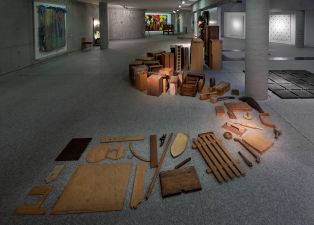- Découvrez les collections
- Notice d'oeuvre



Aller plus loin :
Liverpool, 1949 ;
1984
H. 161 cm ; l. 455 cm ; P. 300 cm ; VOLUM. 21,9765
M0536_85.4.1
À ses débuts, Tony Cragg s’intéresse au Land Art, courant né aux États-Unis dans les années 1960, qui utilise l’environnement naturel comme point de départ de la création artistique. Cette œuvre fait notamment écho au travail de l’artiste anglais Richard Long, pionnier dans sa démarche de collecte puis d’assemblage géométrique d’éléments prélevés dans la nature. Tony Cragg récolte quant à lui les objets lors de « randonnées urbaines ». Ici, ce sont des objets en bois abandonnés qui ont retenu son attention. Un contraste se crée entre la disparité des éléments et l’unité qui se dégage de l’ensemble. Tony Cragg les associe en effet en fonction de leur matériau et de leur couleur, en traçant une forme simple, ici une ligne courbe, un « S », qui progresse de la planiéité vers la 3D. La démarche de Tony Cragg s’inscrit dans la mouvance de la nouvelle sculpture anglaise des années 1970, mais aussi dans la lignée des Nouveaux Réalistes, attachés au « recyclage poétique du réel urbain, industriel, publicitaire » (Pierre Restany, l’un des fondateurs du mouvement en 1960). Tony Cragg interpelle le spectateur sur son rapport aux objets et sur le sens qu’ils prennent dans son quotidien.
At the start of his career, Tony Cragg was interested in Land Art, a movement which originated in the United States in the 1960s using the natural environment as the starting point for art. This piece is reminiscent of the work of the British artist Richard Long, a pioneer in the technique of scavenging elements from the natural world and arranging them in geometric forms. Tony Cragg collects his objects on “urban walks”. In this instance, abandoned wooden items attracted his attention. A contrast is created between the disparate elements and the overall sense of unity which emerges from the ensemble. Tony Cragg groups them by material and colour to form a simple shape, a curved line – an “S” – which moves from a one dimensional plane to 3D. Tony Cragg’s approach belongs to the new sculpture movement in Britain in the 1970s, but also has links with the New Realists, who were keen on “poetic recycling of urban, industrial and advertising reality” according to Pierre Restany, one of the founders of the movement in 1960. Tony Cragg challenges viewers’ relationships with objects and the meanings which they have in their everyday life.


 Copyright© WebMuseo 2017 - 2024
Copyright© WebMuseo 2017 - 2024